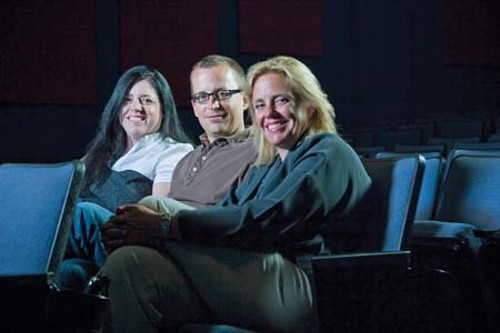Something Wicked This Way Comes
An arts district one block from Temple Square will either save Main Street or become its biggest folly yet.
By Geoff GriffinPage 2 of 4
Wicked Economics
For
Becker’s downtown vision to take hold, he must first convince the local
arts community his grand idea won’t put them out of business.
“I
have been sensitive from the very beginning that we need to do this in
a way that serves the existing performing arts community and does not
detract from their ability to function,” Becker says.
But John Caywood, Kingsbury Hall operations manager, begs to differ, arguing if Becker’s performing arts center is built, and touring Broadway shows end up there rather than at Kingsbury, his facility could lose about $400,000 per year.
“For us, that’s the difference between operating in the black and operating in the red,” he says.
Furthermore,
some in the existing arts community wonder why there’s any need to
improve on what has come about organically. “I take exception to the
term ‘cultural district,’” says Jerry Rapier, producing director of
Plan-B Theater Company. “One already exists. The Rose Wagner, Capitol
Theatre and Abravanel Hall are all within a block of each other.”
Even
in terms of distance, some question if a downtown arts district needs
to be confined to a few city blocks. Chris Lino, managing director of
Pioneer Theatre Company at the University of Utah, notes that the
distance between Temple Square and Pioneer Theatre is less than the
distance between the northernmost and southernmost theaters on Broadway
in New York City, and is easily accessible by TRAX. “It’s 13 blocks,”
he says. “We’re not talking 20 miles away.”
The
question of the performing-arts center, in particular, and having the
government try to help push along a downtown arts scene in general,
seems to come down to economic philosophy. Some existing organizations
see the battle for arts dollars as a zero-sum game, with Becker’s
proposals merely creating more entities trying to get a share of the
same pie. Becker and other proponents of the center say the new
facility would help to grow the overall size of the arts pie, with
everyone still getting their share and the audience getting more
offerings.
Becker says he is “committed to not tapping existing arts revenue sources,” but also notes, “public arts facilities will always need to be subsidized by public funds.”
Charles
Morey, Pioneer Theatre Company artistic director, contends a downtown
performing arts center would end up “robbing from one to fill another.
Will there be more product? Yeah. Will the market sustain more product?
You already have major arts organizations teetering on the brink.”
Lino
notes the Wasatch Front has recently added facilities such as Rio Tinto
Stadium, where a recent concert by the Eagles failed to sell out. He
worries that projections about who will pay for entertainment can be
overblown. “The mania for building is already playing out, and it’s not
playing out the way the proponents said it would,” he says. Becker
thinks the center will help grow the overall arts market because it
will attract new folks to downtown Salt Lake City, people who normally
don’t have a reason to go there. It will also open up the entire arts
marketplace for people who might otherwise only seek out one aspect of
it. “There are people who go to Wicked, but not to the ballet,”
he says. “We need to draw those people into the performing arts.” He
also stresses that the center is more than just Broadway shows; it
would also include a variety of entertainment forms.
Scott Beck says the convention and visitors bureau takes a regional perspective when looking at what Salt Lake City can offer because, “people in Wyoming and Idaho see Salt Lake City as their place.” He further notes that Salt Lake City has grown to where it can compete with Denver and Phoenix on a regional level.
While Beck agrees that “there are only so many dollars a family has to spend on arts and culture activities,” he is reminded that the city had a similar situation with hotels a few years ago. Local hoteliers worried about their survival when the Grand America and other hotel properties opened up in advance of the Olympics, but the end result was the city ended up with more lodging choices, which, according to Beck, brought in more visitors and ended up being more beneficial to all involved.
Could a similar situation occur in an arts economy? Both sides point to the recent run of sold-out performances for Wicked at the Capitol Theatre as proof of their theories.
Lino says it proves that “these shows are coming anyway”—while Becker says Wicked would have come sooner with cheaper ticket prices if Salt Lake City had a facility large enough to draw first-run shows.
Caywood and Geilmann say touring Broadway companies don’t look at size of facility when deciding where to go first, but rather the size of the overall market. With the Salt Lake area sitting at 35th in the nation in terms of size, Caywood says, “There’s no way Salt Lake City is going to get a first- or second-run national tour.”
More by Geoff Griffin
-
A Family New Year
How to ring in 2020 with revelers of all ages.
- Dec 25, 2019
-
The 12 Arts of Christmas
A delightful dozen options for your holiday entertainment needs.
- Nov 27, 2019
-
Season Kickoff
A look at what's new, or old but great, at Utah's ski and snowboard resorts for the winter season.
- Nov 13, 2019
- More »
Latest in Cover Story
Readers also liked…
-
Forget the family pedigree—Robert F. Kennedy Jr should not be the next president of the United States
Trojan Horse
- Jun 21, 2023
-
Women decry harassment and toxic culture at St. George auto dealership
Men at Work
- Oct 11, 2023





